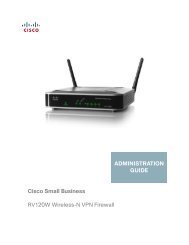Cisco Catalyst 6500 Supervisor 2T Architecture - Ipland
Cisco Catalyst 6500 Supervisor 2T Architecture - Ipland
Cisco Catalyst 6500 Supervisor 2T Architecture - Ipland
You also want an ePaper? Increase the reach of your titles
YUMPU automatically turns print PDFs into web optimized ePapers that Google loves.
White PaperFigure 4. Fabric Channel Layout in 6513-EFabric Replication ASICThis ASIC is used to provide a number of important functions. First and foremost, it receives packets from the frontpanel GE and 10GE ports, extrapolates valuable information from packet headers, and forwards this information tothe PFC4 for packet lookup and associated forwarding services processing (Security, Quality of Service, NetFlow,and others). When packets return from packet lookup processing, this ASIC will perform packet rewrites according tothe lookup result.Another important processing role performed by this ASIC is multicast replication. This includes IGMP snooping forLayer 2 packets, as well as multicast expansion for Layer 3 multicast packets. Additionally, other replication servicesare supported to provision switched port analyser (SPAN, ER-SPAN, and more) capabilities.New capabilities also include support for <strong>Cisco</strong> TrustSec (CTS) and Virtual Switch Link (VSL). Given that, the frontpanel 10 GE ports can be used to become part of a VSL that facilitates the creation of a Virtual Switching System(VSS) domain.Port ASICThere are two port ASICs on the <strong>Supervisor</strong> used to provision the front panel 2 x 10GE and 3 x 1 GE ports. One portASIC supports a single 10 GE port and a single GE port. The other port ASIC supports a single 10 GE port and twoGE ports. The following list defines this port ASIC’s capabilities:● Per-port VLAN translation● VSL support (10 GE ports only)● <strong>Cisco</strong> TrustSec support (802.1ae link layer encryption)● Jumbo frames (up to 9216 bytes)● Flow control● 1P3Q4T (one strict priority queue, three normal round robin queues, and four Weighted Random EarlyDetection [WRED] thresholds per normal queue) queue structure for GE ports (this is the TX queue structure)● 1P7Q4T (one strict priority queue, seven normal round robin queues, and four WRED thresholds per normalqueue) queue structure for 10 GE ports (this is the TX queue structure)● 1Q8T (one normal round robin queues and eight WRED thresholds for that queue) queue structure for 1 GEports (this is the RX queue structure)● 2Q4T (two normal round robin queues and four WRED thresholds per normal queue) queue structure for 10GE ports (this is the RX queue structure)● 256 MB total queue buffer (split among the front panel 10 G and 1 G ports)● DWRR, WRR, and SRR scheduling schemes● WRED and Tail Drop congestion management© 2011-2012 <strong>Cisco</strong> and/or its affiliates. All rights reserved. This document is <strong>Cisco</strong> Partner Confidential Information. Page 12 of 46
















